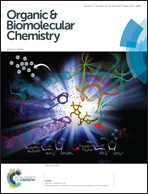Fundamental reaction pathway and free energy profile of proteasome inhibition by syringolin A (SylA)†
Abstract
In this study, molecular dynamics (MD) simulations and first-principles quantum mechanical/molecular mechanical free energy (QM/MM-FE) calculations have been performed to uncover the fundamental reaction pathway of proteasome with a representative inhibitor syringolin A (SylA). The calculated results reveal that the reaction process consists of three steps. The first step is a proton transfer process, activating Thr1-Oγ directly by Thr1-Nz to form a zwitterionic intermediate. The next step is a nucleophilic attack on the olefin carbon of SylA by the negatively charged Thr1-Oγ atom. The last step is a proton transfer from Thr1-Nz to another olefin carbon of SylA to complete the inhibition reaction process. The calculated free energy profile demonstrates that the second step should be the rate-determining step and has the highest free energy barrier of 24.6 kcal mol−1, which is reasonably close to the activation free energy (∼22.4–23.0 kcal mol−1) derived from the available experimental kinetic data. In addition, our computational results indicate that no water molecule can assist the rate-determining step, since the second step is not involved in a proton transfer process. The obtained mechanistic insights should be valuable for understanding the inhibition process of proteasome by SylA and structurally related inhibitors at a molecular level, and thus provide a solid mechanistic base and valuable clues for future rational design of novel, more potent inhibitors of proteasome.


 Please wait while we load your content...
Please wait while we load your content...